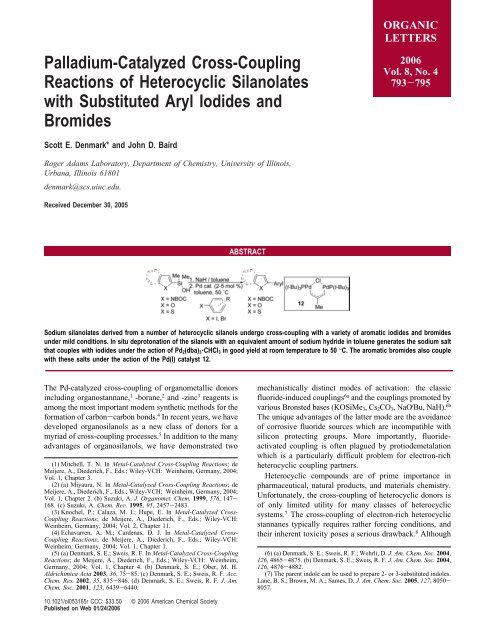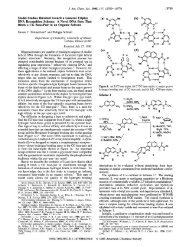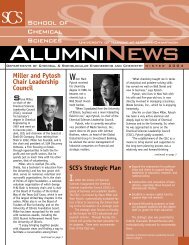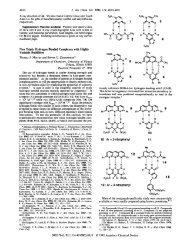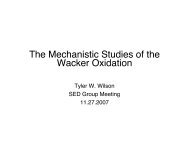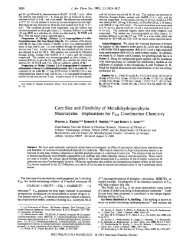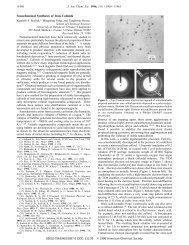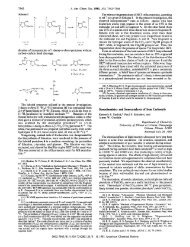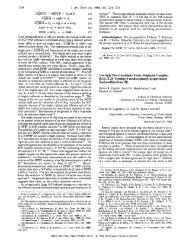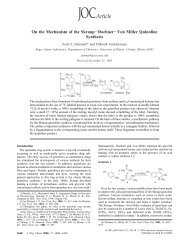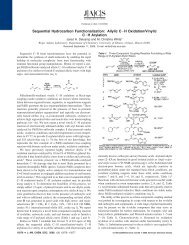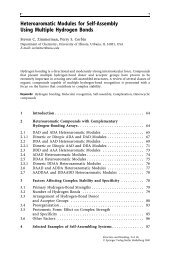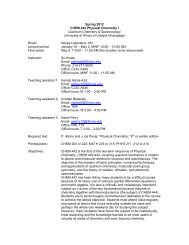Palladium-Catalyzed Cross-Coupling Reactions of Heterocyclic ...
Palladium-Catalyzed Cross-Coupling Reactions of Heterocyclic ...
Palladium-Catalyzed Cross-Coupling Reactions of Heterocyclic ...
You also want an ePaper? Increase the reach of your titles
YUMPU automatically turns print PDFs into web optimized ePapers that Google loves.
<strong>Palladium</strong>-<strong>Catalyzed</strong> <strong>Cross</strong>-<strong>Coupling</strong><br />
<strong>Reactions</strong> <strong>of</strong> <strong>Heterocyclic</strong> Silanolates<br />
with Substituted Aryl Iodides and<br />
Bromides<br />
ORGANIC<br />
LETTERS<br />
2006<br />
Vol. 8, No. 4<br />
793-795<br />
Scott E. Denmark* and John D. Baird<br />
Roger Adams Laboratory, Department <strong>of</strong> Chemistry, UniVersity <strong>of</strong> Illinois,<br />
Urbana, Illinois 61801<br />
denmark@scs.uiuc.edu.<br />
Received December 30, 2005<br />
ABSTRACT<br />
Sodium silanolates derived from a number <strong>of</strong> heterocyclic silanols undergo cross-coupling with a variety <strong>of</strong> aromatic iodides and bromides<br />
under mild conditions. In situ deprotonation <strong>of</strong> the silanols with an equivalent amount <strong>of</strong> sodium hydride in toluene generates the sodium salt<br />
that couples with iodides under the action <strong>of</strong> Pd 2 (dba) 3 ‚CHCl 3 in good yield at room temperature to 50 °C. The aromatic bromides also couple<br />
with these salts under the action <strong>of</strong> the Pd(I) catalyst 12.<br />
The Pd-catalyzed cross-coupling <strong>of</strong> organometallic donors<br />
including organostannane, 1 -borane, 2 and -zinc 3 reagents is<br />
among the most important modern synthetic methods for the<br />
formation <strong>of</strong> carbon-carbon bonds. 4 In recent years, we have<br />
developed organosilanols as a new class <strong>of</strong> donors for a<br />
myriad <strong>of</strong> cross-coupling processes. 5 In addition to the many<br />
advantages <strong>of</strong> organosilanols, we have demonstrated two<br />
(1) Mitchell, T. N. In Metal-<strong>Catalyzed</strong> <strong>Cross</strong>-<strong>Coupling</strong> <strong>Reactions</strong>; de<br />
Meijere, A., Diederich, F., Eds.; Wiley-VCH: Weinheim, Germany, 2004;<br />
Vol. 1, Chapter 3.<br />
(2) (a) Miyaura, N. In Metal-<strong>Catalyzed</strong> <strong>Cross</strong>-<strong>Coupling</strong> <strong>Reactions</strong>; de<br />
Meijere, A., Diederich, F., Eds.; Wiley-VCH: Weinheim, Germany, 2004;<br />
Vol. 1, Chapter 2. (b) Suzuki, A. J. Organomet. Chem. 1999, 576, 147-<br />
168. (c) Suzuki, A. Chem. ReV. 1995, 95, 2457-2483.<br />
(3) Knochel, P.; Calaza, M. I.; Hupe, E. In Metal-<strong>Catalyzed</strong> <strong>Cross</strong>-<br />
<strong>Coupling</strong> <strong>Reactions</strong>; de Meijere, A., Diederich, F., Eds.; Wiley-VCH:<br />
Weinheim, Germany, 2004; Vol. 2, Chapter 11.<br />
(4) Echavarren, A. M.; Cardenas, D. J. In Metal-<strong>Catalyzed</strong> <strong>Cross</strong>-<br />
<strong>Coupling</strong> <strong>Reactions</strong>; de Meijere, A., Diederich, F., Eds.; Wiley-VCH:<br />
Weinheim, Germany, 2004; Vol. 1, Chapter 1.<br />
(5) (a) Denmark, S. E.; Sweis, R. F. In Metal-<strong>Catalyzed</strong> <strong>Cross</strong>-<strong>Coupling</strong><br />
<strong>Reactions</strong>; de Meijere, A., Diederich, F., Eds.; Wiley-VCH: Weinheim,<br />
Germany, 2004; Vol. 1, Chapter 4. (b) Denmark, S. E.; Ober, M. H.<br />
Aldrichimica Acta 2003, 36, 75-85. (c) Denmark, S. E.; Sweis, R. F. Acc.<br />
Chem. Res. 2002, 35, 835-846. (d) Denmark, S. E.; Sweis, R. F. J. Am.<br />
Chem. Soc. 2001, 123, 6439-6440.<br />
mechanistically distinct modes <strong>of</strong> activation: the classic<br />
fluoride-induced couplings 6a and the couplings promoted by<br />
various Bronsted bases (KOSiMe 3 ,Cs 2 CO 3 , NaO t Bu, NaH). 6b<br />
The unique advantages <strong>of</strong> the latter mode are the avoidance<br />
<strong>of</strong> corrosive fluoride sources which are incompatible with<br />
silicon protecting groups. More importantly, fluorideactivated<br />
coupling is <strong>of</strong>ten plagued by protiodemetalation<br />
which is a particularly difficult problem for electron-rich<br />
heterocyclic coupling partners.<br />
<strong>Heterocyclic</strong> compounds are <strong>of</strong> prime importance in<br />
pharmaceutical, natural products, and materials chemistry.<br />
Unfortunately, the cross-coupling <strong>of</strong> heterocyclic donors is<br />
<strong>of</strong> only limited utility for many classes <strong>of</strong> heterocyclic<br />
systems. 7 The cross-coupling <strong>of</strong> electron-rich heterocyclic<br />
stannanes typically requires rather forcing conditions, and<br />
their inherent toxicity poses a serious drawback. 8 Although<br />
(6) (a) Denmark, S. E.; Sweis, R. F.; Wehrli, D. J. Am. Chem. Soc. 2004,<br />
126, 4865-4875. (b) Denmark, S. E.; Sweis, R. F. J. Am. Chem. Soc. 2004,<br />
126, 4876-4882.<br />
(7) The parent indole can be used to prepare 2- or 3-substituted indoles.<br />
Lane, B. S.; Brown, M. A.; Sames, D. J. Am. Chem. Soc. 2005, 127, 8050-<br />
8057.<br />
10.1021/ol053165r CCC: $33.50<br />
Published on Web 01/24/2006<br />
© 2006 American Chemical Society
the cross-coupling <strong>of</strong> arylboronic acids has enjoyed great<br />
success, many heterocyclic boronic acids remain problematic<br />
as they are unstable to long-term storage and suffer rapid<br />
protiodeborylation under reaction conditions. 9 We have<br />
recently reported the cross-coupling <strong>of</strong> N-Boc(2-indolyl)-<br />
dimethylsilanol (1) with aryl iodides under mild conditions<br />
in good yields. 10a The silanol is a robust, shelf-stable reagent<br />
that is ideally suited for the synthesis <strong>of</strong> 2-substituted indoles.<br />
In our hands, the corresponding boronic acid decomposed<br />
within days.<br />
The original procedure for the cross-coupling <strong>of</strong> 1 with<br />
iodides required the use <strong>of</strong> CuI (1.0 equiv) and NaO t Bu (2<br />
equiv) along with Pd 2 (dba) 3 ‚CHCl 3 (5 mol %). 10a Under<br />
Bronsted base activation, we propose that the cross-coupling<br />
proceeds through a key silicon-oxygen-palladium intermediate<br />
prior to the transmetalation step. 6b The activator<br />
serves to generate a metal silanolate which then forms a<br />
palladium-silanolate complex. The role <strong>of</strong> CuI in the<br />
reaction remains unclear. We hypothesized that if the sodium<br />
silanolate was generated by deprotonation with NaH the<br />
requisite sodium silanolate would be formed quantitatively<br />
without a conjugate acid in the medium.<br />
We were delighted to find that the sodium silanolates<br />
generated in situ from NaH were active in the cross-coupling<br />
reaction and that these reactions proceeded smoothly in the<br />
absence <strong>of</strong> CuI. In the cross-coupling <strong>of</strong> 4-iodoanisole (2a),<br />
the previous conditions required heating the reaction at 50<br />
°C for 24 h to furnish the product in 72% yield. Using the<br />
in situ formed silanolate, this product is generated in a<br />
comparable 68% yield in just3hat80°C without CuI (Table<br />
1, entry 1).<br />
method was compatible with aryl iodides bearing nitrile<br />
groups, which were previously problematic when using<br />
NaO t Bu, to furnish 3c in 81% yield (entry 3). 10a<br />
A series <strong>of</strong> electron-rich heterocyclic 2-silanols were<br />
prepared including pyrrolyl (4), thienyl (5), and furyl (6). 11<br />
These silanols were all easily obtained by metalation and<br />
trapping with either hexamethylcyclotrisiloxane or trapping<br />
with dimethyldichlorosilane followed by aqueous hydrolysis.<br />
The N-Boc (2-pyrrolyl)dimethylsilanol 4 was chosen for ease<br />
<strong>of</strong> removal <strong>of</strong> the Boc protecting group. 12,13<br />
Following the conditions outlined above, 4 coupled<br />
smoothly with ethyl 4-iodobenzoate (2b) and 2-iodotoluene<br />
(2d) but required mild heating to effect the cross-coupling<br />
<strong>of</strong> 2a (Table 2, entries 1-3). Other in situ generated<br />
heterocyclic silanolates were also tested. For example, Na + 5 -<br />
provided the desired cross-coupling products from 2b and<br />
2d in3hatroom temperature; however, 2a required heating<br />
to effect complete conversion (entry 4). Furylsilanol 6<br />
exhibited enhanced reactivity with 2b, furnishing the desired<br />
product in 1hin82%yield. Tolyl derivate 2d reacted with<br />
Na + 6 - in a manner similar to that <strong>of</strong> Na + 4 - and afforded<br />
9d in 61% yield in 3 h. Surprisingly, the cross-coupling <strong>of</strong><br />
2a with Na + 6 - proved challenging and required a catalytic<br />
amount <strong>of</strong> (2-furyl) 3 As to reach completion (entry 7).<br />
Table 2.<br />
Iodides<br />
<strong>Cross</strong>-<strong>Coupling</strong> <strong>of</strong> <strong>Heterocyclic</strong> Silanols with Aryl<br />
Table 1. Formation <strong>of</strong> Sodium Silanolate Na + 1 - in Situ and<br />
<strong>Cross</strong>-<strong>Coupling</strong> with Aryl Iodides<br />
entry R temp, °C time, h product yield, a %<br />
1 4-OMe 80 3 3a 68<br />
2 4-CO 2Et rt 3 3b 82<br />
3 4-CN rt 3 3c 81<br />
a Yield <strong>of</strong> chromatographed, recrystallized products.<br />
entry X R temp, °C time, h product yield, a %<br />
1 N-Boc 4-OMe 50 36 7a 72<br />
2 N-Boc 4-CO 2Et rt 3 7b 76<br />
3 N-Boc 2-Me rt 3 7d 80<br />
4 S 4-OMe 80 24 8a 72<br />
5 S 4-CO 2Et rt 3 8b 78<br />
6 S 2-Me rt 3 8d 79<br />
7 b O 4-OMe 50 24 9a 71<br />
8 O 4-CO 2Et rt 1 9b 82<br />
9 O 2-Me rt 3 9d 61<br />
a Yield <strong>of</strong> chromatographed products purified by recrystallization or<br />
sublimation. b Required the use <strong>of</strong> 0.2 equiv <strong>of</strong> (2-furyl) 3As for complete<br />
conversion.<br />
Because NaO t Bu can induce transesterification, we surmised<br />
that the milder silanolate base would be compatible<br />
with ester groups. Indeed, the in situ prepared Na + 1 - afforded<br />
smooth conversion to the desired product 3b in 82% yield<br />
in3hatroom temperature (entry 2). Further, the in situ<br />
(8) (a) Labadie, S. S.; Teng, E. J. Org. Chem. 1994, 59, 4250. (b) Kang,<br />
S.; Baik, T.; Song, S. Synlett 1999, 327-329.<br />
(9) Tyrrell, E.; Brookes, P. Synthesis 2004, 469-483.<br />
(10) Denmark, S. E.; Baird, J. D. Org. Lett. 2004, 6, 3649-3652. See<br />
also: (b) Denmark, S. E.; Kallemeyn, J. M. J. Org. Chem. 2005, 70, 2839-<br />
2842.<br />
The positive results with aryl iodides encouraged us to<br />
investigate the cross-coupling <strong>of</strong> aryl bromides with in situ<br />
(11) The synthesis <strong>of</strong> 2-substituted thiophenes can be achieved from<br />
silanes. Nakao, Y.; Imanaka, H.; Sahoo, A. K.; Yada, A.; Hiyama, T. J.<br />
Am. Chem. Soc. 2005, 127, 6952-6953.<br />
(12) The corresponding N-Boc(2-pyrrolyl)boronic acid is a poor substrate<br />
for cross-coupling reactions as it suffers from rapid protiodeborylation and<br />
also undergoes a competing homodimerization. Johnson, C. N.; Stemp, G.;<br />
Anand, N.; Stephen, S. C.; Gallagher, T. Synlett 1998, 1025-1027.<br />
(13) <strong>Cross</strong>-coupling reactions <strong>of</strong> 2-thienyl- and 2-furylboronic acids<br />
typically employ 2.0 equiv <strong>of</strong> the boronic acids. Kondolff, I.; Doucet, H.;<br />
Santelli, M. Synlett 2005, 2057-2061.<br />
794 Org. Lett., Vol. 8, No. 4, 2006
generated sodium silanolates. For optimization studies, we<br />
chose Na + 5 - and 4-bromoanisole (10a) as the electrophile.<br />
Initial conditions using Pd 2 (dba) 3 ‚CHCl 3 (5 mol %) were<br />
unsuccessful, so we surveyed several Pd sources with 1,1-<br />
di-tert-butylphosphinobiphenyl 11 at 50 °C which has been<br />
successfully employed with aryl bromides in other crosscoupling<br />
studies within our group. 14<br />
Disappointingly, PdCl 2 and PdBr 2 did not catalyze the<br />
cross-coupling <strong>of</strong> 6 with 10a in the presence <strong>of</strong> 11 (Table 3,<br />
entries 1-3). The use <strong>of</strong> an allylpalladium chloride dimer<br />
in conjunction with 11 brought about complete conversion<br />
in 3 h, although the desired arene 8a was accompanied with<br />
11% <strong>of</strong> the homocoupling product (entry 4). The Pd(I)<br />
catalyst 12, which has been shown to be a highly active Pd<br />
source for the cross-coupling <strong>of</strong> arylboronic acids, afforded<br />
clean conversion to 8a within 3 h without the formation <strong>of</strong><br />
the homocoupling side product (entry 5). 15 Furthermore, the<br />
loading <strong>of</strong> 12 can be decreased to 2.5 mol % with no loss in<br />
activity.<br />
a hexane solution <strong>of</strong> 1 to a stirred suspension <strong>of</strong> 1.0 equiv<br />
<strong>of</strong> NaH in toluene afforded a white precipitate whose identity<br />
was confirmed by NMR and HRMS as Na + 1 - . The salt was<br />
a stable, free-flowing white powder. We were pleased to find<br />
that this reagent possessed reactivity similar to that for the<br />
in situ prepared silanolate in reaction with 2b and Pd 2 (dba) 3 ‚<br />
CHCl 3 to afford 3b in 76% yield. The other silanolates,<br />
Na + 5 - and Na + 6 - , were prepared analogously but were<br />
formed as stable waxes which were nonetheless still easily<br />
manipulated. The cross-coupling <strong>of</strong> Na + 5 - and Na + 6 - with<br />
2b and Pd 2 (dba) 3 ‚CHCl 3 gave the desired products in 87%<br />
and 79% yields, respectively. Storing the active silicon<br />
species as the sodium salt provides two advantages. First,<br />
the reaction procedure is simplified by only having to charge<br />
the active silanolate into the reaction vessel instead <strong>of</strong> adding<br />
both the silanol and the activator. Second, the dimerization<br />
<strong>of</strong> silanols to their corresponding disiloxanes 17 is prevented<br />
by storing the sodium salts.<br />
Table 3. Catalyst and Ligand Optimization for the<br />
<strong>Cross</strong>-<strong>Coupling</strong> <strong>of</strong> Aryl Bromide 10a with Na + 5 -<br />
Table 4.<br />
Bromides<br />
<strong>Cross</strong>-<strong>Coupling</strong> <strong>of</strong> Silanolates with Substituted Aryl<br />
entry Pd source ligand, a mol % time, h conversion, % b<br />
1 PdCl 2 10 12 trace<br />
2 PdBr 2 10 12 4<br />
3 PdBr 2 20 24 trace<br />
4 [allylPdCl] 2 20 3 100 c<br />
5 Pd(I) catalyst 0 3 100<br />
a Employed 1,1-di-tert-butylphosphinobiphenyl as an additive. b Area %<br />
by GC analysis. c Accompanied with 11% <strong>of</strong> the product <strong>of</strong> aryl bromide<br />
homocoupling, as determined by 1 H NMR analysis.<br />
The cross-coupling <strong>of</strong> Na + 5 - and Na + 6 - proceeded<br />
smoothly with a range <strong>of</strong> aryl bromides providing the desired<br />
products in moderate to good yields (Table 4). Most reactions<br />
were complete within 3 h, although the cross-coupling <strong>of</strong><br />
1-bromonaphthalene was slower requiring 7 and6htoreach<br />
completion for Na + 5 - and Na + 6 - , respectively. However,<br />
the cross-coupling <strong>of</strong> Na + 6 - with 10a stalled at 78%<br />
conversion to give the product in 66% yield (entry 7). 16<br />
To corroborate our hypothesis that the sodium silanolate<br />
is the active silicon intermediate, we prepared Na + 1 - and<br />
tested its competence under the reaction conditions. Adding<br />
entry X R time, h product yield, a %<br />
1 S 4-OMe 3 8a 71<br />
2 S 4-CO 2Et 3 8b 67<br />
3 S 4-CN 3 8c 78<br />
4 S 2-Me 3 8d 77<br />
5 S 4-CF 3 3 8e 86<br />
6 S<br />
b<br />
7 8f 74<br />
7 c O 4-OMe 6 9a 66<br />
8 O 4-CO 2Et 3 9b 60<br />
9 O 4-CN 3 9c 73<br />
10 O 2-Me 3 9d 71<br />
11 O 4-CF 3 3 9e 71<br />
12 O<br />
b<br />
6 9f 69<br />
a Yield <strong>of</strong> chromatographed products purified by sublimation. b 1-<br />
Bromonaphthalene. c Reaction stalled at 78% conversion.<br />
In conclusion, we have developed a simplified and general<br />
procedure for the cross-coupling <strong>of</strong> in situ generated and<br />
isolated heterocyclic silanolates with aryl iodides and<br />
bromides. Extension to more complex heterocycles is in<br />
progress.<br />
Acknowledgment. We are appreciative for generous<br />
financial support from the National Institutes <strong>of</strong> Health<br />
(R01GM61738). J. D. B. acknowledges the University <strong>of</strong><br />
Illinois for a graduate fellowship.<br />
Supporting Information Available: Preparation <strong>of</strong> Na + 1 -<br />
and all sodium silanolates, detailed experimental procedures,<br />
and full characterization <strong>of</strong> all products. This material is<br />
available free <strong>of</strong> charge via the Internet at http://pubs.acs.org.<br />
(14) Wolfe, J. P.; Singer, R. A.; Yang, B. H.; Buchwald, S. L. J. Am.<br />
Chem. Soc. 1999, 121, 9550-9561.<br />
(15) (a) Weissman, H.; Ray, C. R.; Elliott, E. L.; Moore, J. S. AdV. Synth.<br />
Catal., submitted for publication. (b) Weissman, H.; Shimon, L. J.; Milstein,<br />
D. Organometallics 2004, 23, 3931-3940.<br />
(16) The cross-coupling <strong>of</strong> the N-Boc-(2-indolyl)- and (2-pyrrolyl)-<br />
dimethylsilanols with arylbromides was unsuccessful. Significant amounts<br />
<strong>of</strong> phenol were observed when the reactions were run at 80 °C. We believe<br />
OL053165R<br />
the phenol is derived from a competing reductive elimination to form a<br />
dimethylsilyl ether that is hydrolyzed upon aqueous workup. (17) Lickiss, P. D. AdV. Inorg. Chem. 1995, 42 147-262.<br />
Org. Lett., Vol. 8, No. 4, 2006 795


